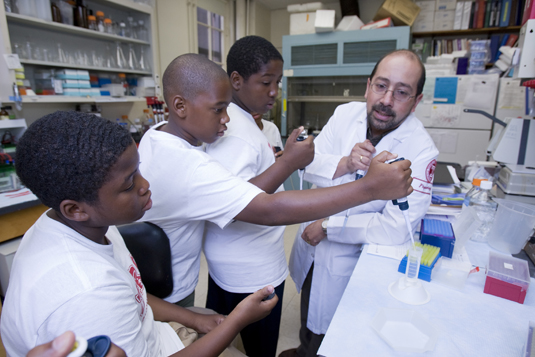Real Science
|
||||||||||
|
The concepts of science can be complicated. But Mario Rico, an associate scientist in Temple University’s School of Medicine, found a way to explain titration — the process of adding a re-agent to a substance to produce a predetermined reaction — in a way that any middle schooler could understand. How? By relating it to a popular summer drink. “Think of Kool-Aid,” he said. “If you put too much sugar in it, it becomes too thick. If you put in too little sugar, it won’t be sweet enough. It has to have just the right amount of sugar to be good.” Rico was addressing 10 summer camp students from the H.E.R.O. (Helping Energize and Rebuild Ourselves) Community Center, at 17th and Tioga Streets, who came to the Medical School for a tour and a chance to get a little hands-on scientific experience. The idea for the visit arose from a meeting with the Community Resource board of the Medical School’s Center for Minority Health and Health Disparities. Doris Phillips, executive director of the H.E.R.O Community Center and a member of the board, suggested a program that would expose young people to careers in medicine. Raul De La Cadena, assistant dean and director of the Medical School’s recruitment, admission and retention program, offered his time and his laboratory to give the students a chance to conduct real medical research. The center has since applied for a National Institutes of Health grant that could create a summer-long experience that could expose more students to careers in medicine, De La Cadena said. “The [Community Resource Board] came up with what we hope will be a structural program with H.E.R.O,” he said. “The plan is to tap into the resources of the Health Sciences Campus year-round to expose kids to these opportunities.” The board also hopes that exposing the kids to the medical school and teaching them about health will help connect their parents with some of the community health programs available via the medical school, Phillips said. “If we get the young people involved, they can talk with their parents,” she said. “That could open doors for them to become more involved.” As the group of students waited for the results of the titration experiment, some contemplated the possibility of a career in science. Joslyn Vaughn, 12, who conducted an experiment to determine whether or not a protein sample contains the H1N1 virus, proclaimed that that science was one of two career interests. “I like singing, but I also like science,” he said. “Scientists try to find cures for things.” Eric Weeks, 12, was hoping for something even more hands-on. “I was told that we were going to dissect an onion,” he said. But while the others were interested in the experiments they’d get to do that day, 12-year-old Zaynah Sayles, a budding pediatrician, considered her visit Temple’s audition. “I’m hoping to learn if [Temple] is a good school for me to learn medicine,” she said. |
|
